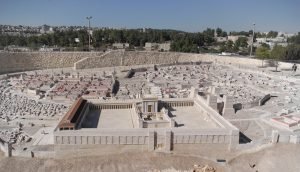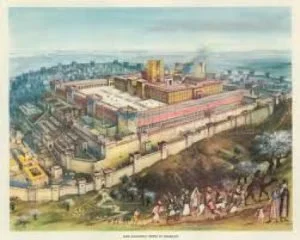The Location of the Ancient Jewish Temples
Where were the Jewish Temples located in the city of Jerusalem? A new book and video contend it was in the more ancient part of the city, the one David captured from the Jebusites, sitting over the Gihon Spring. Is the traditional site of the Temple Mount in Jerusalem just a long misunderstood mistake?
In the past generation, the Palestinian Authority has famously and wrongly denied the existence of any Temples in Jerusalem. But more recently, a pastor has revived the long discredited theory of pseudo-archaeologist Ernest Martin, that the Temple actually stood in the original city of Jerusalem, called the City of David, located on the Southern slope of Mount Moriah. The major contention of this theory is that there wasn’t sufficient water to wash away the blood of sacrifices at the location of what has always been understood to be the Temple Mount. So, in this theory, it's argued that the traditional Temple Mount was actually the Antonia Fortress and the real location of the Temple was in the City of David, over the Gihon Spring.
This theory is so wrong that it defies logic. But the problem is that in this internet age, all one needs is a free video and some publicity, and suddenly, people begin wondering if the historic Temple Mount is the legitimate site of the ancient Jewish Temples or has there been some sort of historical error or hoax.
There are many strong academic works (for example, one by Leen Rittmeyer and another by Randall Price) that show just how wrong this theory is. However, here are just a few reasons explaining why the Temple stood exactly where it was always thought to stand, on the Temple Mount in Jerusalem.
Let’s start with the issue of water. To begin, no one would build a Temple over a major source of water for a city. Therefore, the Temple could not have been built over the Gihon Spring. But then, how did the ancient Jewish people bring water to the Temple Mount? Recently, archaeologist Eli Shukrun discovered an ancient reservoir just West of the Temple Mount in the Tyropean Valley which brought water to the Temple Mount via aqueduct. According to him, this reservoir “supplied water for daily use in the Temple.”
Another reason for accepting the traditional site of the Temple is that according to 2 Chronicles 3:1, the Temple location was on the Threshing Floor of Arunah. Ancient threshing floors were never put in actual cities but outside of them, so the wind could winnow wheat from chaff. Arunah’s threshing floor would not have been in the city of the Jebusites, that David conquered and made his capital. It makes perfect sense for the threshing floor to be in the elevated place just North of David’s city and for David to choose that site for the Temple and for Solomon to use it to build it.
A further issue that is frequently raised is that the Lord Jesus said of the Temple, “Do you see these great buildings? Not one stone will be left here on another that will not be thrown down” (Mark 13:2; cf. Matt 24:1-2; Lk 21:5-6). So it is asked, how can the Western Wall, the site where Jewish people have gathered to pray for two millennia, still be standing? This misunderstands what the Western Wall actually is. It was not the Western Wall of the Temple, but the Western Wall of the platform that Herod the Great built to support the massive Temple complex he designed. The words of the Lord Jesus literally came true when the Romans razed the Temple complex and destroyed every building in it. The Western Wall was not part of that.
Beyond these arguments, the size of the Temple provides another bit of evidence. The original Temple of Solomon measured 861’ by 861’ or about three football fields in size. That would have been far too large to be in the city of David—it just would not fit. If that’s the case, how could the much larger Temple Herod built (about ten football fields) fit in the City of David?
Still another reason to accept the traditional site of the Temple Mount is that archaeology supports it. There are the Southern Steps to the Temple Mount, found just where the ancient Jewish historian Josephus said they would be. There is the famous trumpeting stone, found on the street just below the SW corner of the Temple Platform. It was the stone that marked the site where the trumpet was blown to announce the Sabbath. The Romans threw it over the side when they destroyed the buildings on the Temple complex. Another inscription separating the court of the Gentiles was found outside the northeast corner of the Temple complex, far from the City of David . These and other discoveries from the Temple Mount sifting project have yielded clear evidence that the Temple Mount was indeed the Temple Mount.
Finally, one more reason to trust the traditional site of the Temple Mount has to do with Jewish memory. Since the destruction of the Temple, we Jewish people have gathered at the Western Wall of the Temple platform to pray. The location was chosen because it was just beneath the site where the Holy of Holies had been. So Jewish people for two millennia have identified the Temple Mount as the Temple Mount. It's unreasonable to think that the Jewish people could have gotten the site wrong so near to the time of the Temple's destruction.
Beware of internet conspiracy theories and sensational books designed to distract believers from the truth. Just remember, sometimes the facts of history are just that, facts

